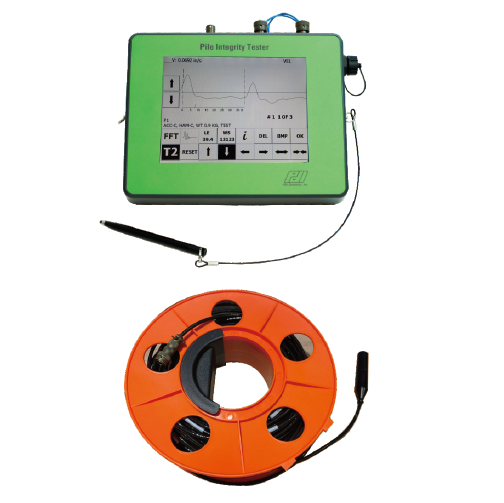The Parallel Seismic test method can determine the depth of a foundation for which as-built records are unavailable. The procedure includes an instrumented hand-held hammer impacting the exposed top of the foundation or the foundation’s cap to generate compression waves in the pile and soil. The waves travel down the foundation and are refracted into the surrounding soil. The refracted wave arrival is tracked at regular intervals by a hydrophones in a PVC cased borehole. The depth of the foundation is determined by plotting the recorded wave forms as a function of depth and time and observing the depth where a change of slope in first arrival time occurs.
Parallel Seismic Test Method:
•Can be used to test driven piles without joints or splices
•Provides unknown depth of foundations substructure elements
•Can be used on concrete, timber, masonry, and steel foundations
Parallel Seismic Procedure:
The Parallel Seismic test method requires drilling a cased borehole parallel to and near the tested pile, usually within 1 to 5 feet of the foundation element and should extend at least 16 feet deeper than the anticipated foundation depth (unless solid bedrock is encountered during drilling). The borehole must be drilled as vertical as possible, cased with PVC pipes, capped at the bottom; and, for the hydrophones receiver, be filled with water prior to testing. The hydrophones is lowered into the borehole to a specified depth and the top of the foundation element is hit with the instrumented hammer producing a stress wave that propagates along the length of the element. Some of the wave’s energy also propagates laterally into the surrounding soil. A hydrophones lowered to a measured depth in the borehole receives the pressure wave, allowing the PIT Collector to record hammer and hydrophones data versus time. The hydrophones is then lowered to the next specified depth increment and the procedure is repeated. This process is repeated for the length of the borehole extending beyond the expected length of the foundation element. All the collected data is then added to a chart plotting the time domain response verses the depth that it was recorded. Due to the differences in the wave speeds between the foundation element and the surrounding soil, once the hydrophones has passed through the bottom of the foundation element there will be a change in the first arrival time. This is shown Figure 1, for a foundation element of approximately 17 feet. Parallel Seismic meets or exceeds the requirements of ASTM D8381.

 Enquiry:hkmarketing@epc.com.hk
Enquiry:hkmarketing@epc.com.hk  Whatsapp Enquiry: +85261990717
Whatsapp Enquiry: +85261990717












